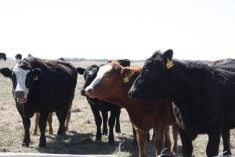This cattle market information is selected from the weekly report from Canfax, a division of the Canadian Cattlemen’s Association. More market information, analysis and statistics are available by becoming a Canfax subscriber by calling 403-275-5110 or at www.canfax.ca.
Fed prices lower
Alberta fed prices eased lower last week on reduced post-July 4 summer wholesale demand and increasing North American market-ready supplies. Most of last week’s limited trade was reported $3-$4 per hundredweight lower than the previous week dressed at $406 delivered.
Read Also

Flax sector sees omega-3 opportunity
SASKATOON — A global shortage of omega-3 oils could be an opportunity for the flax sector, says an industry official….
Light live trade was comparable from $240.25-$243 per cwt. Weighted average steer prices eased $2.62 per cwt. lower than the previous week to $242.11.
Cash market competition was limited as one major packer pulled in bids and shifted focus to formula pricing. Canadian fed cattle/cow exports to the United States for the week ending June 24 firmed nine percent larger to 7,502 head and were 11 percent lower than the same week last year.
Year-to-date exports were down five percent to 233,843 head.
Light Ontario trade was reported $5 per cwt. lower than dressed trade seen the previous week at $400 per cwt. delivered. Feedlot managers were not motivated sellers.
With grid base prices firming higher and anticipated larger market-ready supplies entering the American beef pipeline, cash prices are being pressured lower. Alberta fed cattle supplies are contra-seasonally moderate. and cattle feeders should maintain sufficient market leverage to limit cash market downside.
In the U.S, light live trade in the south was generally steady to US$1 per cwt. lower than the previous week at $178 per cwt. Northern live sales were reported from $179-$185 per cwt., with the bulk trading steady to $1 per cwt. lower than the previous week at $182-$183.
Dressed sales were fully steady with the previous week at $290 per cwt. delivered.
Total U.S. slaughter for the shortened four-day week was estimated 17 percent smaller than the previous week at 539,000 head and eight percent lower than year ago.
Butcher cows steady
Butcher cow prices have traded sideways over the past five weeks, ranging from $151-$154 per cwt. Alberta cow prices are trading $3.50 per cwt. shy of their highs set in late May. Last week D2s averaged $153.50, and D3s averaged $138.17 per cwt. Slaughter bulls averaged $163.06.
Non-fed volumes through commercial auction facilities have been much larger than normal for this time of the year. This is showing up in the slaughter data as western Canadian cow slaughter volumes run well above last year and the five-year average.
The next 60 days are traditionally a strong time for the non-fed market. On a monthly basis over the past 30 years, July has the highest probability of seeing second-half-of-the-year highs, as this has occurred 16 times.
Volumes are not large, but with dry conditions across parts of the Prairies, we’re starting to see a few cow-calf pairs being split, which is adding a few more cows to the slaughter mix.
Yearlings come off grass
There was a good mix of backgrounded feeders and yearlings marketed off grass. In some instances, grass yearlings are being marketed 60 days earlier than normal. In general, grass cattle are trading at roughly a $10 per cwt. premium compared to background feeders.
New and old crop barley prices continue to rise, strengthening $20 per tonne over the past few weeks. Western Canadian feedlots are actively booking U.S. corn for fall delivery and into the new year.
The forward delivery calf market was lightly tested. British Columbia, Alberta and Saskatchewan five-weight steer calves for mid-October to early November delivery traded from $367-$391 per cwt., with a weighted average price of $380.10 per cwt. based at 541 lb.
Forward delivery prices are trading at roughly an eight percent premium compared to the spot market. From a seasonal perspective, it is rare to see calf prices rally into the fall. Over the past 10 years, annual price highs have only occurred during the second half of the year three times (2013, 2014 and 2022).
Canadian feeder cattle imports from the U.S. for April totalled more than 17,000 head, the lowest import volume seen this year. Cow-calf pairs traded from $2,650-$3,575, averaging $3,000 per pair.
U.S. cutouts soften
In U.S. beef trade, cutouts eased lower last week, moving into the dog days of summer. Choice and Select were both down 2.5 percent. Choice averaged US$319.87 and Select averaged 289.97 per cwt.














